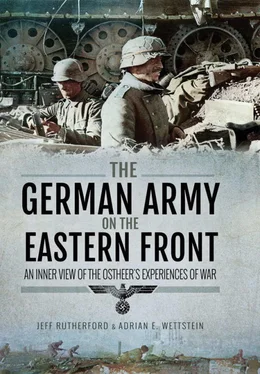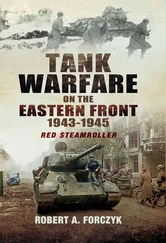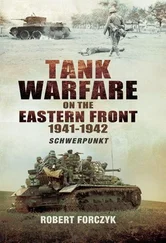Immediately after the first fire strikes of our own weapons, the enemy started to return fire. His artillery fire partly targeted our jumping-off area. On our side, the first severe losses occurred even before we had even started the attack. The spearhead group of wedge III that was lying behind a pile of stones on the railway line received a direct hit. One man died, four were severely wounded, including the leader of the spearhead. Due to another hit on the second assault group of the second wedge (behind the house on the railway embankment), a group leader and four men fell out of the fighting. Weakened in leaders and enlisted men in this way, the spearheads attacked.
Wedge I: Advanced from Hall 3, it worked forward by several rushes, but was stopped at the locomotive shed by violent machine-gun fire from Hall 4 and took a defensive position with a front towards Hall 4.
Wedge II: Under cover of early morning darkness, the assault group advanced over craters and rubble to the right front corner of Hall 4. Suppressed by concentrated defensive fire (close combat arms), the spearhead could not push into the hall from here as planned. An advance on the right external wall seemed the only possibility. Extremely heavy machine gun fire from the first right entry blocked the further advance of Feldwebel Fetzer’s spearhead. Feldwebel Fetzer knocked out that machine gun with a satchel charge, ordered a part of his group to get in and then led the mass of his unit forward to the second side door. Our own machine gun provided the necessary covering fire. Shot at by enemy snipers firing through hatches, openings and hidden nooks, the spearhead penetrated into the hall from the side. The inextricable mess of iron parts, debris from the wall, destroyed machines, twisted beams and rubble demanded the highest concentration and decisively delayed the advance. The men were dazed by the chaos before their eyes. It was impossible to take a secure step, as there was no footing in the jumble of iron pieces. Inevitably, attention was therefore kept off the enemy. At once, concentrated enemy defensive fire from all directions opened up after the penetration. Satchel charges, hand grenades, and submachine gun salvos hindered all further advances to main Hall 4. The enemy was surprisingly strong. It was a matter of massed forces, which included in addition to the well camouflaged defensive units, behind steel parapets and iron containers, riflemen in open positions. It was determined, among other things, that fire came from numerous thick-walled iron tanks with small fire openings. The walls of these tanks were around 15cm thick and they could withstand even satchel charges. In many cases these tanks were piled upon one another and this allowed a skilful flanking fire. With the utmost effort and satchel charges, as well as hand grenades, the group – after penetrating 30-40m into the hall – secured the side wall as rear cover. After the loss of its best soldiers, it worked back to door 1, very well supported from the squad left back there, and retreated to the locomotive hall.
Wedge III: Due to preliminary losses that left it severely weakened, the assault wedge reached the front side of the hall. The assault group leader already was lost. The spearhead blasted the wire-blocked entrance with satchel charges and penetrated a few meters into the hall. The enemy’s uncontrollable defensive fire, partly from nearby, brought further losses. The enormous chaos inside the hall prevented any observation. A further penetration was not possible.
Wedge IV: Despite the loss of the leader, who was severely wounded after a few minutes, and many men, the assault wedge worked quickly forward on the left outside wall and penetrated under cover of the dawn along the freight cars up to 30-40m in front of Hall 4. Heavy fire from the rear and from openings of the side wall opened up at sunrise, causing many losses. An attempt to create a connection to the right was made by blasting the side wall of the hall. This intention failed. In the process, the deputy commander of the assault wedge fell, as he received a shot to his heart while bandaging an arm wound. The remaining men had to retreat.
All wedges suffered further losses, including among others two wounded artillery spotters due to hidden sniper fire, and through artillery and mortars. The difficult rescue of the wounded claimed numerous victims.
The enemy’s concentrated and surprisingly heavy defensive fire, as well as the quick readiness of the artillery raises suspicions that our attack was carried out against an enemy who was prepared for a major attack. From this point of view, our defeated attack should be marked as a success for the defence.
Losses: […] Total: 1/6 dead, 12/26 wounded, 0/4 missing, 0/5 frostbite [NCOs/enlisted men].
Such losses meant that no less than 50 per cent of the units’ initial strength was lost in a single attack, one that achieved no gains. It was therefore no surprise that the commander of the battalion justified his unit’s failure in the last sentence of the report. Obviously command and control proved very difficult to achieve on such a chaotic and fragmented battle site. These types of combat situations led German forces to rely on commanders leading their troops from the front, consequently resulting in high losses among junior officers. This command practice is why no lost officers were mentioned in the attack above – by this stage of the battle, the battalion commander was the only remaining officer in the entire unit! German infantry tactics typically utilized assault groups in platoon, or even sometimes smaller, size. The units would push forward to a given line, while reserves would then ‘clean-up’ the overrun area. These assault groups normally included a mix of weapons, relying heavily on automatic weapons (e.g. submachine guns) and were lightly equipped. The next wave of forces could rely on heavier weapons, such as ATGs (anti-tank guns) and infantry guns, single artillery pieces or heavy flak guns, including the famous 88mm gun, to reduce strongholds. Realizing that their preparatory fire only hindered their mission by creating more rubble and alerting the Soviet defender to an oncoming attack, the Germans limited the duration of their initial bombardments.
After being ground down by such urban fighting, the German Sixth Army was encircled and destroyed by Red Army forces, finally surrendering on 2 February 1943. Unlike the defeat in front of Moscow in 1941, which forced the Germans back several hundred kilometres but which failed to remove large formations from the German order of battle, the destruction of Sixth Army and the loss of four Axis armies completely unhinged German forces in the southern part of the Soviet Union. Due to the shift in initiative across the entire front as result of the battle of Stalingrad, scorched earth retreats became part of the German army’s arsenal on the battlefield. In spring 1943, two nearly simultaneous retreats of this nature took place. In late February/early March, elements of Army Group North’s Sixteenth Army cleared the Demiansk Pocket, while Army Group Centre’s Ninth Army carried out a similar retreat from the Rzhev salient. [35]The following order from IXth Army Corps provides a glimpse at how such retreats were understood and planned for by the German army in early 1943. [36]
I. In General
1) Every opportunity to do harm to the enemy, to slow down his movement, [and] to disrupt his supply is to be exploited.
The divisions are responsible for the destruction in their movement corridors.
The engineer commanders are commissioned for the scouting, preparation and carrying out.
2) The carrying-out of the destruction is to be arranged according to an exact plan of destruction .
3) All destruction is to be brought into harmony with the troop’s tactical movements.
Читать дальше






![John Stieber - Against the Odds - Survival on the Russian Front 1944-1945 [2nd Edition]](/books/405234/john-stieber-against-the-odds-survival-on-the-russian-front-1944-1945-2nd-edition-thumb.webp)





